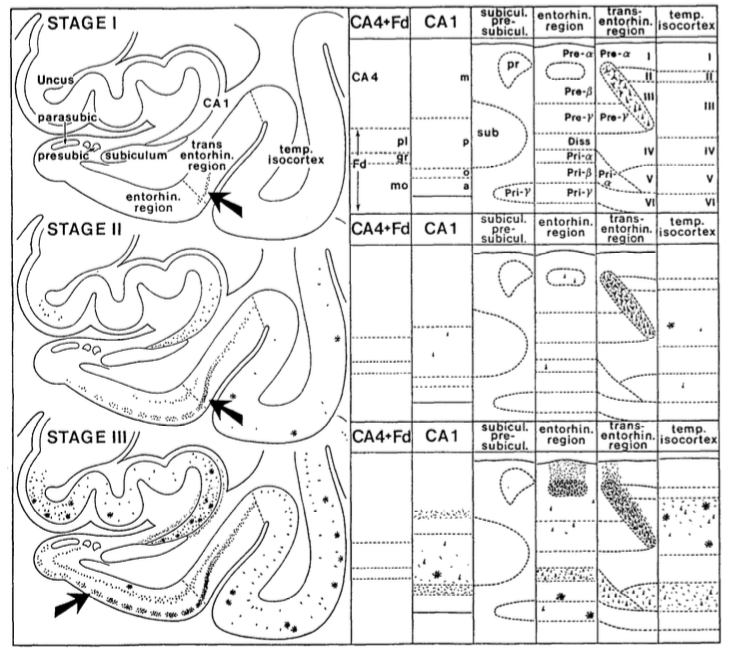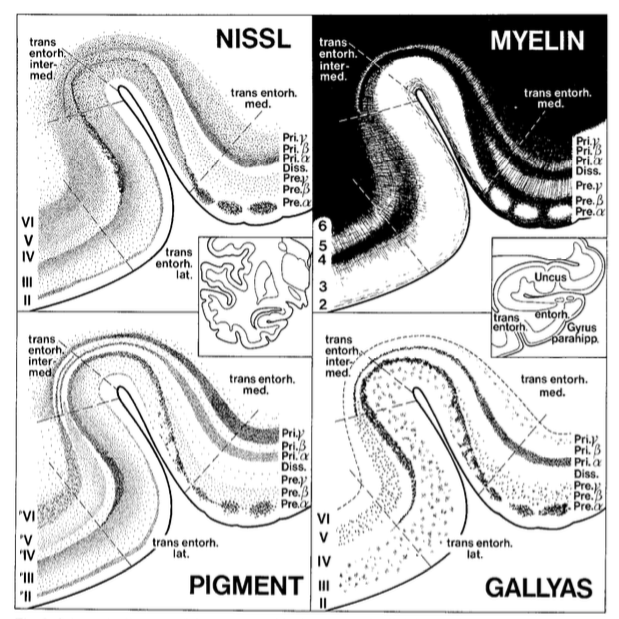Discover and read the best of Twitter Threads about #subfieldwednesday
Most recents (15)
Guest post by @DrAnaDaugherty on hippocampal (Hc) vascularization.
Brought to you by “anastomosis” (noun): a cross-connection between adjacent blood vessels; plural “anastomoses”.
As in, “Wow! 54 years of mapping anastomoses”
#SubfieldWednesday 🧵 1/

Brought to you by “anastomosis” (noun): a cross-connection between adjacent blood vessels; plural “anastomoses”.
As in, “Wow! 54 years of mapping anastomoses”
#SubfieldWednesday 🧵 1/


The unique features of its arteries make Hc vulnerable to anoxia. Superficial arteries travel long tangential routes, and intrahippocampal arteries have few anastomoses and travel with the rolling CA and dentate gyrus tissue. 2/
#SubfieldWednesday
#SubfieldWednesday
Posterior cerebral (PCA) & anterior choroidal (AChA) arteries supply Hc. Variations are noted: PCA supply is typical and dominant, AChA supply is not seen in 30-40% of hemispheres.
🚨Anastomosis Alert (arrows) 3/
tinyurl.com/2hjaw6vj
#SubfieldWednesday
🚨Anastomosis Alert (arrows) 3/
tinyurl.com/2hjaw6vj
#SubfieldWednesday

Last week we talked about hippocampal variability in the hippocampal head.
The hippocampal tail is another area of the hippocampus that can vary anatomically across individuals
#SubfieldWednesday (1/n)
The hippocampal tail is another area of the hippocampus that can vary anatomically across individuals
#SubfieldWednesday (1/n)

But first, what do we mean by the hippocampal tail? Definitions vary, but one way to define the tail is the part of the hippocampus located posterior to the corpora quadrigemina (i.e. superior and inferior colliculi).
#SubfieldWednesday (2/n)

#SubfieldWednesday (2/n)


The hippocampal dentations that can be visualized in the hippocampal body on the sagittal plane (pointed out earlier by @thomcat992). But they can also often be seen in the coronal plane in the hippocampal tail (as shown by @lemwisse and colleagues).
#SubfieldWednesday (3/n)


#SubfieldWednesday (3/n)



Today we continue our thread series discussing anatomical variability in the medial temporal lobe (MTL). Today’s topic is anatomical variability in the hippocampal head with a focus on the hippocampal digitations. 🍤🤓📢
#SubfieldWednesday (1/n)
#SubfieldWednesday (1/n)
But first, what do we mean by the hippocampal head? We are talking about the anterior part of the hippocampus that contains or is adjacent to the uncus.
#SubfieldWednesday (2/n)
#SubfieldWednesday (2/n)

Now what about those “hippocampal digitations” ?
Ding & Van Hoesen (2015) describe external and internal digitations. The external digitations are the “bumps” that extend dorsally and the interior digitations are the “bumps” that extend ventrally.
#SubfieldWednesday (3/n)

Ding & Van Hoesen (2015) describe external and internal digitations. The external digitations are the “bumps” that extend dorsally and the interior digitations are the “bumps” that extend ventrally.
#SubfieldWednesday (3/n)


Happy #SubfieldWednesday! Today we will be sharing a 🧵 on anatomical variability in the medial temporal lobe (MTL). MTL subregions vary in size and shape across individuals & these variations can make landmark identification and segmentation difficult
#SubfieldWednesday (1/n)
#SubfieldWednesday (1/n)
Today we will focus on the *most* consistent structure in the MTL: the hippocampal body. Most of our followers will be familiar with this canonical hippocampal body shape shown below in the coronal plane.
#SubfieldWednesday (2/n)
#SubfieldWednesday (2/n)

The shape is characterized by a consistent “C-shape” when viewed in the coronal plane. The C is formed by the cornu ammonus (CA) subfield on the lateral part of the hippocampal body.
#SubfieldWednesday (3/n)
#SubfieldWednesday (3/n)
Is anyone planning to do some reading about hippocampal neuroanatomy over the holidays?
If you answered, "yes", this week's #SubfieldWednesday is for you! We will give you a list of "must read" atlas references about our favorite brain structure. 🍤❣️
#SubfieldWednesday (1/n)
If you answered, "yes", this week's #SubfieldWednesday is for you! We will give you a list of "must read" atlas references about our favorite brain structure. 🍤❣️
#SubfieldWednesday (1/n)
In our 2015 paper (Yushkevich et al., NeuroImage, 2015), we provided a list of common atlases used for hippocampal subfield definition across labs.
#SubfieldWednesday (2/n)
#SubfieldWednesday (2/n)

One of the most commonly used atlases cited was:
Duvernoy, H. M. (2005). The human hippocampus: functional anatomy, vascularization and serial sections with MRI. Springer Science & Business Media.
#SubfieldWednesday (3/n)

Duvernoy, H. M. (2005). The human hippocampus: functional anatomy, vascularization and serial sections with MRI. Springer Science & Business Media.
#SubfieldWednesday (3/n)


This week I thought I would share some terminology that you may or may not know!
#SubfieldWednesday (1/n)
#SubfieldWednesday (1/n)
Most of our followers probably already know how that the name "hippocampus" means "seahorse" in Greek.
#SubfieldWednesday (2/n)
#SubfieldWednesday (2/n)

What do you think? When it's dissected like this, I can definitely see the similarity!
#SubfieldWednesday (3/n)
#SubfieldWednesday (3/n)

Two weeks ago we tested your ability to recognize the hippocampal subfields from histology! See the next tweet below to find out if you identified all five subfields correctly! #SubfieldWednesday
please unroll @threadreaderapp
Hello and happy #SubfieldWednesday! Today we are going to get a bit more familiar with how the hippocampal subfields differ in their composition of different cell types, cell sizes, and layer thickness. 🍤🔬
#SubfieldWednesday (1/n)
#SubfieldWednesday (1/n)
Here are some images taken from five different hippocampal subfields (CA1, CA2, CA3, dentate gyrus, and subiculum). Can you tell which number corresponds to which subfield? 🤔
#SubfieldWednesday (2/n)
#SubfieldWednesday (2/n)

Because a Nissl stain was applied to these slices, the cell bodies appear dark purple. This allows neuroanatomists to characterize the size, shape, and relative spacing of the cells.
#SubfieldWednesday (3/n)
#SubfieldWednesday (3/n)
Happy #SubfieldWednesday! After a two-week hiatus we are returning to our quiz about the mysterious transentorhinal cortex!
This quiz even stumped some of us at @hipposubfields headquarters! We had to contact a neuroanatomist to confirm which answer is correct! (or at least "the most correct")
Last week we received over 100 (!) responses on our quiz about which hippocampal subfield accumulates tau pathology earliest in the disease.
#SubfieldWednesday (1/n)
#SubfieldWednesday (1/n)
This week we will explain that the correct answer for Alzheimer's disease (but not all types of dementia) is CA1!
#SubfieldWednesday (2/n)
#SubfieldWednesday (2/n)
Work from Braak & Braak (1991) showed that CA1 develops tau pathology before the other subfields.
#SubfieldWednesday (3/n)
#SubfieldWednesday (3/n)

Hello subfield-fans! Last week's #SubfieldWednesday topic was the layered composition of the hippocampal subfields. We learned that the subfields contain three major cellular layers which makes them a part of the allocortex.
#SubfieldWednesday (1/n)
#SubfieldWednesday (1/n)

@thomcat992 replied that the hippocampus is archicortex, which is also correct! Archicortex is a type of allocortex.
#SubfieldWednesday (2/n)
#SubfieldWednesday (2/n)
Now what about the entorhinal cortex (ERC)? The ERC has six layers, so does that make it neocortex (also known as the isocortex)?
#SubfieldWednesday (3/n)
#SubfieldWednesday (3/n)
Better late than never! (It's still Wednesday in some timezones!) This week's #SubfieldWednesday will be a bit briefer than normal.
#SubfieldWednesday (1/n)
#SubfieldWednesday (1/n)
Some of you might have been surprised last week when we described the hippocampal subfields as layered structures.
#SubfieldWednesday (2/n)
#SubfieldWednesday (2/n)
Even though the hippocampus sometimes gets grouped together with subcortical structures like the thalamus and basal ganglia, the dentate gyrus, CA fields, and subiculum are all part of a special type of cortex called the allocortex!
#SubfieldWednesday (3/n)
#SubfieldWednesday (3/n)
Two weeks ago we posted about whether you can visualize subfields on in vivo MRI. Here is a link if you missed it!
#SubfieldWednesday (2/n)
#SubfieldWednesday (2/n)
You might recall that the hippocampus is a layered structure (just like the neocortex!) and that some of the layers have different contrast properties due to different amounts of myelination and cell densities
#SubfieldWednesday (3/n)

#SubfieldWednesday (3/n)


This question for this week's #SubfieldWednesday is:
Can you visualize subfields using in vivo magnetic resonance imaging (MRI)? (1/n)
Can you visualize subfields using in vivo magnetic resonance imaging (MRI)? (1/n)
Answer:
Yes, there are specific anatomical features in MRI that we can use to identify different hippocampal subfields (2/n)
#SubfieldWednesday
Yes, there are specific anatomical features in MRI that we can use to identify different hippocampal subfields (2/n)
#SubfieldWednesday
How is this possible? If subfields are defined based on cell types, cell size and density, layer thickness, etc.? Neuroanatomists typically define subfields based on special dyes that stain the cell bodies (e.g. Nissl stain as shown below) #SubfieldWednesday (3/n) 



Drum roll please...it's time for our very first #SubfieldWednesday!
One thing you might be wondering is: How many subfields are there in the human hippocampus and what are they called??
The answer actually depends on who you ask! Let me explain more!
#SubfieldWednesday
The answer actually depends on who you ask! Let me explain more!
#SubfieldWednesday
Most people who study the hippocampal subfields with high resolution MRI recognize CA1, CA2, CA3, CA4, dentate gyrus (DG), and the subiculum as the major subfields of the hippocampus.
That means there are five...right?
#SubfieldWednesday
That means there are five...right?
#SubfieldWednesday



